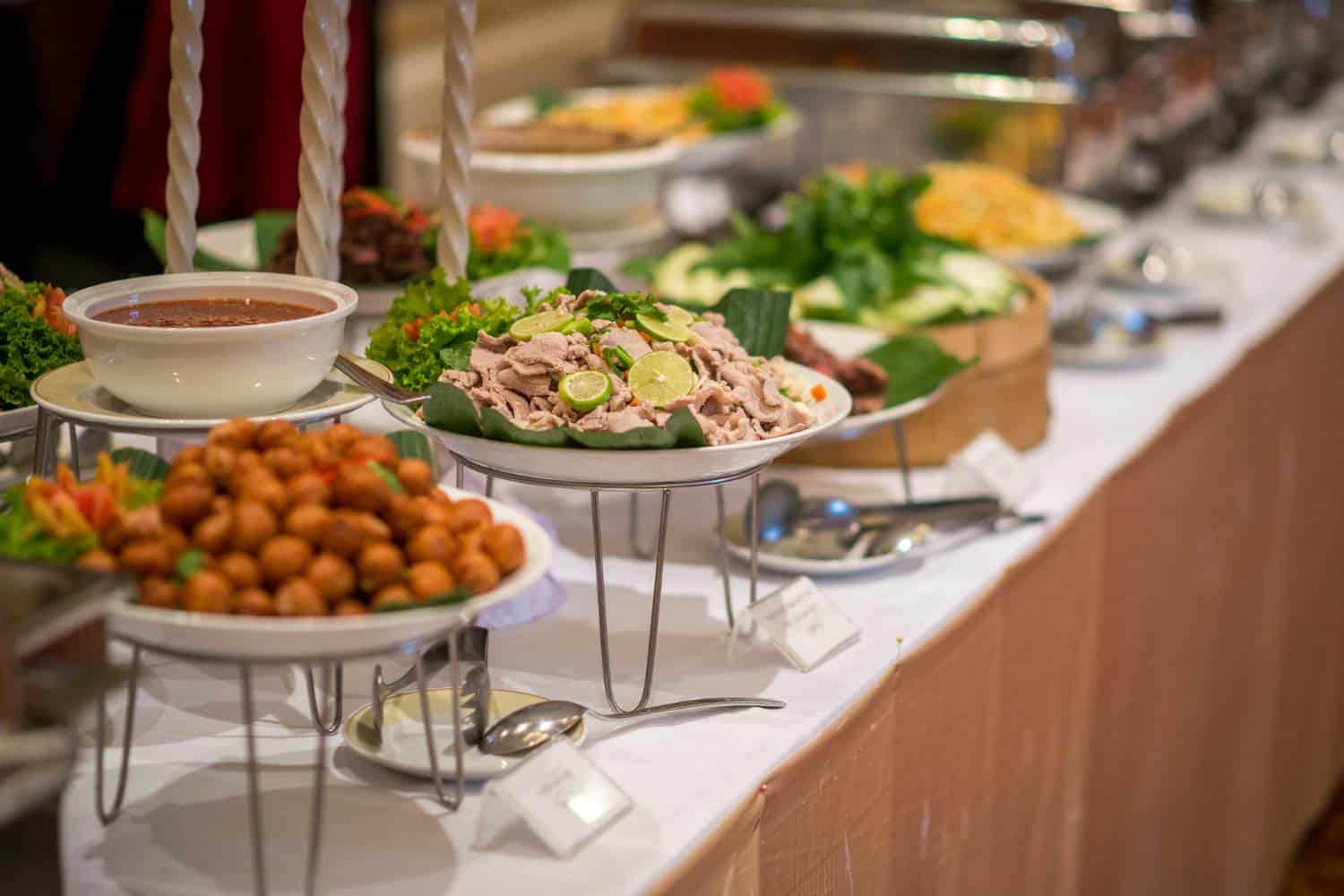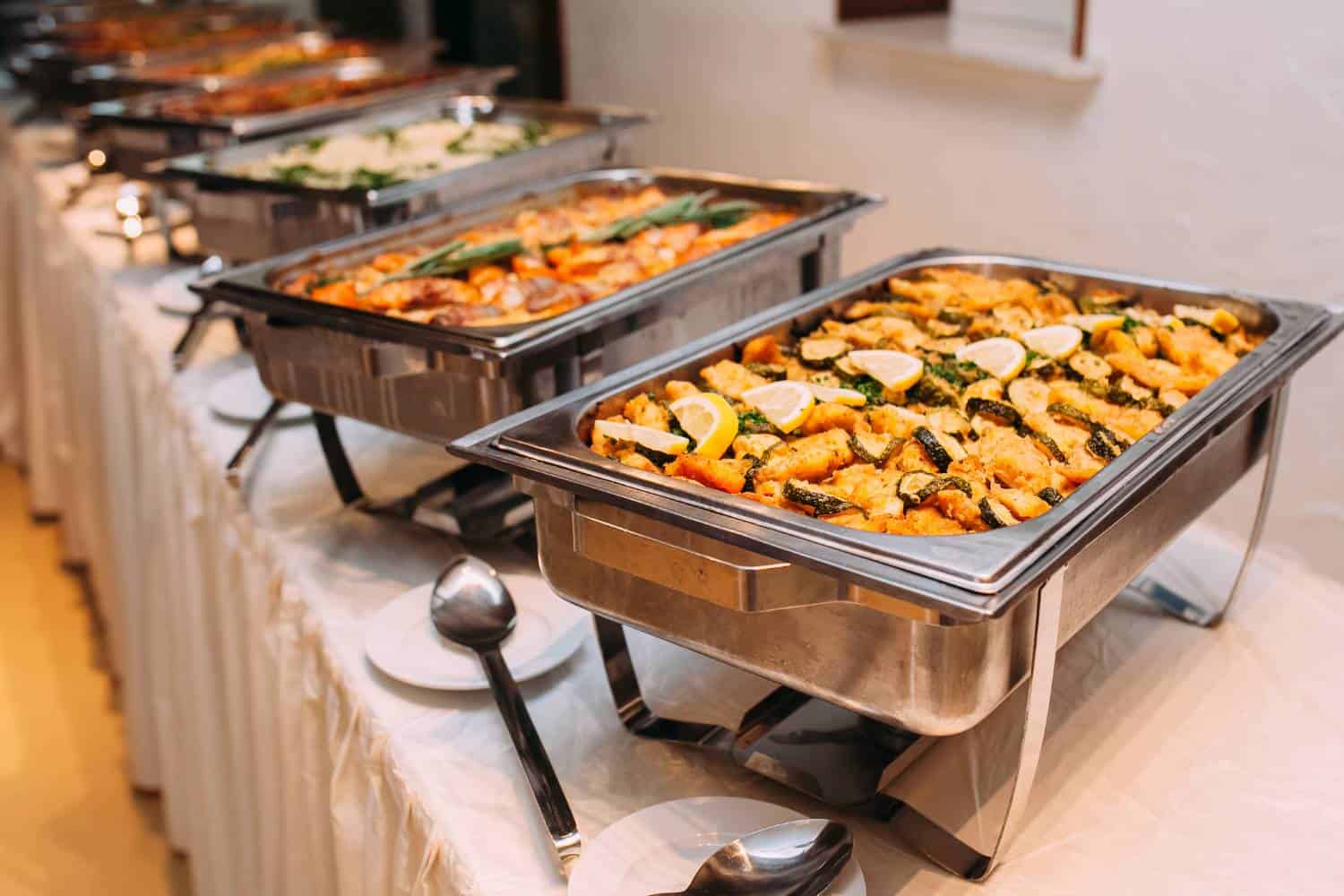Wedding catering is often one of the largest expenses, but there are practical ways to reduce costs without compromising the quality of the experience.
From creative menu choices to cost-effective service styles, this guide offers proven tips on saving money on wedding catering while still providing your guests with a memorable dining experience.
Let’s get straight to the point
To save money on wedding catering without compromising quality, set a clear budget, opt for buffet or family-style service, and limit menu choices to reduce costs.
Use seasonal and local ingredients, avoid expensive luxury items, and simplify hors d’oeuvres. Control alcohol expenses by serving a signature drink or bringing your own alcohol if the venue allows.
Skip unnecessary extras like late-night snacks and reduce dessert options to just the cake.
Consider affordable alternatives like food trucks or casual dining, and negotiate with your caterer for flexible packages. Keep a close eye on your guest list to avoid overpaying for food and drinks.
1. Set a Clear Budget
Setting a clear and realistic budget is the first step to controlling catering costs.
Knowing your financial boundaries helps you make informed decisions about menu choices, service style, and vendor options.
Your budget should account for all elements of catering, including food, drinks, tableware, staff fees, and any extras like a dessert table or bar service.
Tips for Staying Within Budget:
- Allocate a fixed percentage of your overall wedding budget to catering.
- Include hidden costs such as service fees and delivery charges.
- Reassess your guest list to ensure you’re paying for those who truly matter.
By establishing a solid budget, you’ll have a clearer vision of where you can afford to splurge and where you can cut back.
2. Opt for Buffet or Family-Style Service
Choosing a buffet or family-style service is an excellent way to reduce labour costs.
Unlike a formal plated dinner, which requires more staff, a buffet allows guests to serve themselves, and family-style dining involves placing platters on each table for guests to share.
These approaches create a relaxed, communal dining experience while saving money.
Why Buffet and Family-Style Work:
- Fewer staff required: This significantly cuts down on service fees.
- Less food waste: Guests take only what they want, reducing leftovers.
- Flexibility: Both buffet and family-style dining provide more flexibility in portion sizes and menu variety.
These casual dining options are ideal for couples looking to save without sacrificing the quality of their catering.
3. Limit Menu Choices
A smaller menu is a simple way to reduce catering expenses. Rather than offering multiple entrées and an array of appetisers and desserts, streamline your menu to focus on a few key dishes.
Limiting the number of choices reduces the complexity of the preparation process and lowers ingredient costs.
Benefits of a Limited Menu:
- Reduced ingredient costs: Fewer dishes mean buying ingredients in bulk, which is cheaper.
- Streamlined preparation: A shorter menu makes it easier for caterers to prepare and serve.
- Quality over quantity: Focusing on a few well-prepared dishes leaves a lasting impression on guests without breaking the bank.
By offering fewer, high-quality options, you can still wow your guests while staying within budget.
4. Choose Seasonal and Local Ingredients
Using seasonal and locally sourced ingredients can significantly lower your catering costs. When produce is in season, it’s more affordable and readily available.
Similarly, locally grown food is often cheaper as it doesn’t incur high transportation costs.
Not only does this approach save money, but it also enhances the freshness and flavour of your menu.
How to Incorporate Seasonal Ingredients:
- Work with your caterer: Design a menu around what’s in season at the time of your wedding.
- Local farms: Sourcing from nearby farms supports local businesses and reduces transportation costs.
- Flavour boost: Seasonal ingredients are often at their peak, making dishes more flavourful.
This approach benefits your budget while offering your guests a delicious, fresh dining experience.
5. Skip Expensive Ingredients
Luxury ingredients like lobster, wagyu beef, and imported cheeses can quickly escalate catering costs. Instead, opt for more affordable proteins such as chicken, pork, or local seafood.
When prepared by a skilled chef, these budget-friendly options can be just as delicious as their more expensive counterparts.
Affordable Yet Delicious Alternatives:
- Swap lobster for prawns or local fish.
- Choose chicken or pork over premium cuts of beef.
- Opt for locally sourced cheese rather than imported varieties.
You don’t need to spend a fortune on premium ingredients to impress your guests. Affordable options can be just as delightful with the right preparation.
6. Simplify Hors D’oeuvres
Cut down on the number of hors d’oeuvres offered during cocktail hour.
Instead of an extensive selection, limit the appetiser menu to two or three well-chosen items that are easy to prepare in bulk.
Popular, cost-effective options include cheese platters, dips, and bite-sized snacks.
Budget-Friendly Hors D’oeuvre Ideas:
- Cheese and charcuterie boards: Simple but sophisticated.
- Dips and crudités: Fresh vegetables paired with dips offer a light and affordable option.
- Mini sliders or savoury pastries: Easy to make and serve in large quantities.
Simplifying your hors d’oeuvres menu allows you to maintain quality while reducing costs.
7. Serve a Signature Drink
Alcohol is often one of the biggest expenses in wedding catering. To keep costs under control, offer a limited selection of beverages instead of a full bar.
A popular choice is to serve a signature cocktail along with beer and wine. This reduces the need for a wide variety of spirits and mixers while still providing guests with enjoyable drink options.
Ways to Cut Alcohol Costs:
- Choose a signature drink: Limit the cocktail options to a single signature drink.
- Offer beer and wine only: This is a cost-effective way to provide alcohol without the high costs of a full bar.
- Set a drink limit: Establishing a cap on the number of drinks per guest can further reduce alcohol expenses.
By simplifying your alcohol offerings, you can control costs while keeping the drinks flowing.
8. Bring Your Own Alcohol (If Allowed)
Many wedding venues allow couples to bring their alcohol, which can lead to substantial savings. Buying beer, wine, and spirits from a wholesaler is often much cheaper than purchasing them through your caterer.
While some venues may charge a corkage fee to serve your alcohol, this fee is typically lower than the cost of a full bar package.
How to Save on Alcohol:
- Buy in bulk: Purchase wine and beer from a wholesale retailer to save money.
- Compare corkage fees: Even with a corkage fee, bringing your alcohol can still be more affordable.
- Opt for local wines and beers: Support local breweries and wineries to save on shipping costs and contribute to your local community.
If your venue allows BYO alcohol, it’s one of the easiest ways to cut down on your catering bill.
9. Reduce Dessert Options
The wedding cake is often the highlight of the dessert course, but additional dessert options can quickly add up.
Instead of offering multiple desserts, stick to just the cake or set up a simple dessert table with affordable treats like cupcakes or brownies.
Another cost-saving idea is to have a smaller, display cake for the cutting ceremony and serve guests from a sheet cake in the kitchen.
Cost-Effective Dessert Ideas:
- Limit to one dessert: Stick to just the wedding cake or one additional dessert.
- Choose budget-friendly sweets: Brownies, cookies, or cupcakes can be delicious and affordable.
- Serve a smaller cake: A smaller display cake paired with a sheet cake for serving cuts down on costs.
This approach allows you to provide sweet treats without overspending on your catering budget.
10. Consider Food Trucks or Casual Dining
Food trucks or casual dining options are becoming popular, especially for outdoor or relaxed weddings.
Hiring a food truck that serves pizza, tacos, or burgers can create a fun, laid-back atmosphere while significantly reducing costs compared to a traditional sit-down meal.
Benefits of Food Trucks:
- Cost-effective: Typically more affordable than a formal dinner service.
- Unique experience: Adds a fun, informal vibe to your wedding.
- Variety: Food trucks offer diverse menu options, allowing you to cater to various tastes without overspending.
If you’re planning a casual or outdoor wedding, food trucks can offer a unique, affordable dining experience for your guests.
11. Skip the Late-Night Snack
While late-night snacks have become popular at weddings, they are often unnecessary.
Skipping this extra meal can help reduce your overall catering costs. If you still want to offer something for guests who stay late, opt for inexpensive options like popcorn or pretzels.
Affordable Late-Night Snack Ideas:
- Popcorn: Simple, budget-friendly, and satisfying.
- Pretzels or chips: Easy to serve and cost-effective.
Avoiding the extra expense of a late-night meal can free up room in your budget for more essential elements.
12. Negotiate with Your Caterer
Don’t be afraid to negotiate with your caterer or ask about potential discounts.
Many caterers are willing to work within a budget, offering suggestions for simplifying the menu, reducing staff, or shortening service time.
Open communication with your caterer can lead to creative solutions that save money.
Negotiation Tips:
- Be upfront about your budget: Let your caterer know your financial limitations from the start.
- Ask for recommendations: Caterers often have cost-saving ideas that won’t compromise quality.
- Explore package deals: Some caterers offer package deals that bundle food, drinks, and service at a lower price.
By working closely with your caterer, you can find cost-effective solutions without sacrificing the quality of your wedding meal.
13. Keep an Accurate Guest List
Your catering costs will increase with every additional guest, so it’s essential to keep a close eye on your guest list.
Only invite those who are key to your celebration to avoid unnecessary expenses.
Confirm the final guest count with your caterer well in advance to prevent over-ordering food and drink.
Tips for Managing Your Guest List:
- Invite only essential guests: Stick to your close friends and family.
- Confirm final numbers early: Finalise your guest count with your caterer ahead of time to avoid paying for no-shows.
- Track RSVPs: Stay on top of RSVPs to prevent last-minute surprises.
A well-managed guest list ensures you won’t pay for more food and drinks than you need.
Conclusion
Saving money on wedding catering doesn’t mean cutting corners.
Practical strategies such as choosing buffet or family-style service, limiting alcohol options, and incorporating seasonal ingredients can provide a high-quality dining experience while staying within your budget.
Careful planning and communication with your caterer will help you create a wedding menu that’s both affordable and memorable.
Frequently Asked Questions
Why do weddings cater?
Caterers ensure that their menu complements the theme of your wedding. You can rest easy knowing that they can handle every detail, from the flowers to the entertainment to incredible food. A catering service has the potential to make or break your wedding.
Why should you hire a caterer?
Quality: By hiring a professional catering company or chef, you can guarantee that the quality of the food supplied will be of the highest standard.
The higher quality food will have your guests enjoying the food and indeed impressed. The quality of food at an event can make or break the event.
How does catering at a wedding work?
Wedding Caterers Don’t Just Cook The Food
They don’t just cook. They also generally set up your tables and chairs, often coordinate your rentals, provide the waitstaff (and often bartenders), serve the food on time, clean up the dining area and kitchen, pack leftovers, and take away the garbage.
What is expected of a caterer?
Caterer duties and responsibilities
Setting up all tables and food service areas with chairs, linens and dishes. Serving food to guests at events.
Cleaning up and tearing down the dining area by removing all tableware, linens, garbage and furniture. Creating menus according to a client’s preferences and dietary needs.
Do caterers supply plates and silverware?
Many catering services offer plate and flatware rental options or work standard plate and silverware into their pricing.
Beyond adding your table centrepiece and décor touches, you should be able to arrive at your event and not have to lift a finger!



